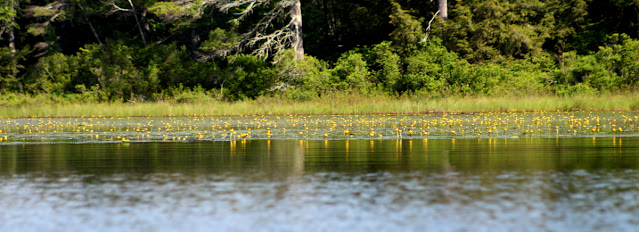Amy Wilson had the sharp eye and key knowledge to discover the loons have selected a nesting site and are incubating an egg - hopefully two. She noted the key sign was a single loon floating in the lake just off a prime nesting island. And these loons are good - the nest is extremely well hidden, impossible to see behind thick vegetation which also provides shade from the intense June sun. Because it's in a popular boating lane but can't be seen, paddlers and fishermen are likely to flush the loon off the nest by passing close to it without ever knowing it's there, so markers have been placed to alert boaters to keep a safe distance from the site.
On Thursday Loon Preservation Committee intern Taylor Tewksbury came to the lake to document the nest.
 |
| LPC intern Taylor Tewksbury inspects a nesting site from a prior year. |
We were able to observe the bands on both loons, confirming their identity: the male banded on Lake Wicwas in 2019 and the female banded on Lake Pemigewasset in 2018. We also were given a great show by the male doing his afternoon grooming. It was so dramatic that we saw it from a far distance and thought there was an altercation taking place.
 |
| From a distance this looked like trouble. |
But no, it was just him grooming and spreading oil, and doing some acrobatics in the process.
 |
| Just some very enthusiastic preening. |
 |
| He was putting on quite a show for us. |
We also observed a shift change. so both parents are doing their part on the nest. This is the same pair that successfully raised Coco and Jimmy last summer so we're hoping for another successful breeding season!
The Canada geese, as usual, are far ahead of the loons and at least one family is already out on the water with their goslings and I expect there will be more soon.
 |
| Two is an unusably small brood for Canada geese. |
We're right in the heart of breeding season for many of our local fauna, and the forest, especially in the morning, is just brimming with the sounds of nature, displaying a plethora of songs stating their presence, whether it's to attract a mate or deter a competitor. One morning there was a nice chorus of bullfrogs singing so I thought I'd capture a bit of the performance. I was so focused on the frogs that I didn't realize there were so many birds accompanying the amphibians. In this recording there are at least five different birds vocalizing, including a veery, common yellowthroat, eastern wood peewee, great crested flycatcher, and at the very end a loud, piercing, broad-winged hawk:
 |
| Yellow Pond-lilies (Nuphar lutea) |
 |
| Lupine |



Love the bullfrogs. It is like being there with them.
ReplyDeleteThanks - a lot of people liked that one!
ReplyDelete